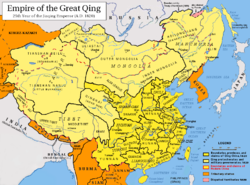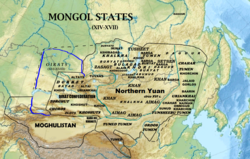The Revolt of the Three Feudatories, (Chinese: 三藩之亂; pinyin: Sānfān zhī luàn) also known as the Rebellion of Wu Sangui, was a rebellion lasting from 1673...
27 KB (2,972 words) - 08:22, 14 April 2025
of some of the rebellions, revolts and revolutions that have occurred in China. The rebellion of Han Zhuo, a 20-year semi-mythological interregnum of...
44 KB (6,567 words) - 16:02, 13 March 2025
Green Standard Army (category Military history of the Qing dynasty)
by the Qing during the revolt. Reform of the Qing military system by the Kangxi Emperor during the last years of the War of the Three Feudatories led...
17 KB (2,084 words) - 10:54, 26 April 2025
Eight Banners (redirect from Banners of Manchuria)
Bannermen. In the Revolt of the Three Feudatories Manchu Generals and Bannermen were initially put to shame by the better performance of the Han Green Standard...
50 KB (6,061 words) - 16:51, 27 May 2025
Kangxi Emperor (redirect from The Kangxi Emperor)
attempt to revoke the fiefdoms of feudal princes sparked the Revolt of the Three Feudatories, which he suppressed. He also forced the Kingdom of Tungning in...
65 KB (7,666 words) - 19:30, 30 May 2025
the Three Feudatories revolt, the Kangxi Emperor made clear that he considered all the southern Fujianese living in Taiwan to be Chinese, unlike the Koreans...
80 KB (9,865 words) - 04:17, 2 May 2025
Transition from Ming to Qing (redirect from Fall of the Ming dynasty)
such as the Revolt of the Three Feudatories led by Wu Sangui in southern China, starting in 1673, and then countered by launching a series of campaigns...
178 KB (21,907 words) - 14:11, 26 May 2025
Qing dynasty (redirect from Empire of the Great Qing)
regent. While the Qing became a Chinese empire, resistance from Ming rump regimes and the Revolt of the Three Feudatories delayed the complete conquest...
156 KB (19,168 words) - 23:29, 27 May 2025
Abunai (category Place of birth unknown)
and his son given his title. In 1675 he led the Chahar Mongols joining in the Revolt of the Three Feudatories, but were defeated in battle in April and...
2 KB (207 words) - 17:20, 31 December 2023
Shang Zhixin (category Template:Succession box: 'after' parameter includes the word 'abolished')
warlord of the early Qing Dynasty, known for his role in the Revolt of the Three Feudatories. He was Prince of Pingnan (平南王, "Prince who Pacifies the South")...
3 KB (436 words) - 11:42, 25 September 2024
Qing dynasty in Inner Asia (category History of Qing dynasty by region)
controlled by the Northern Yuan under Ligdan Khan. After suppressing the Revolt of the Three Feudatories and the conquest of Taiwan as well as ending the Sino-Russian...
29 KB (3,619 words) - 15:25, 8 September 2024
Anti-Qing sentiment (section Overthrow of the Qing)
1675 during the Revolt of the Three Feudatories, with 3,000 Chahar Mongol followers joining in on the revolt. The Qing then crushed the rebels in a battle...
30 KB (3,233 words) - 01:03, 22 April 2025
southwestern Taiwan as the Kingdom of Tungning and attacked the Qing dynasty during the Revolt of the Three Feudatories (1673–1681). In 1683, the Qing invaded Taiwan...
112 KB (14,061 words) - 22:03, 11 May 2025
the Revolt of the Three Feudatories. Kong Sizhen (孔四貞; Kǒng Sìzhēn) is Sun Yanling's wife who is also involved in the Revolt of the Three Feudatories...
53 KB (7,007 words) - 00:15, 25 April 2025
Wu Shifan (category Suicides in the Qing dynasty)
was the grandson of Wu Sangui and his successor as emperor of the Zhou dynasty during the Revolt of the Three Feudatories. He was declared the taisun...
1 KB (80 words) - 20:19, 13 October 2023
Wu Sangui (category History of the Great Wall of China)
their interests, the three revolted and thus began the eight-year-long civil war known as the Revolt of the Three Feudatories. Before the rebellion, Wu sent...
33 KB (4,687 words) - 01:31, 25 May 2025
Revolt of the Three Feudatories between the Emperor and the Han princes, Wu Sangui and Geng Jingzhong, started when they opposed the Emperor's plan of resettling...
3 KB (298 words) - 22:13, 18 October 2023
During is reign, the Qing dynasty entered into an era of prosperity known as the High Qing era. The Revolt of the Three Feudatories was suppressed under...
104 KB (13,605 words) - 09:27, 23 May 2025
during the Revolt of the Three Feudatories, with 3000 Chahar Mongol followers joining in on the revolt. The revolt was put down within two months; the Qing...
5 KB (580 words) - 22:19, 12 March 2025
throne in 1638. He was a supporter of Wu Sangui. After the Revolt of the Three Feudatories was pacificated, he was attacked by Trịnh lord, and fled to Qing...
2 KB (79 words) - 22:27, 18 May 2025
Dương Ngạn Địch (category Generals of the Nguyễn lords)
of Longmen (龍門總兵, a place in modern Qinzhou, Guangxi). In 1679, after the Revolt of the Three Feudatories was put down by the Kangxi Emperor of the Qing...
3 KB (315 words) - 11:18, 10 November 2024
[matters of the] past and present. As a result, during the Jin dynasty (265-419), there occurred the Revolt of the Five Barbarian [Tribes](late in the third...
71 KB (8,211 words) - 22:56, 24 May 2025
the Revolt of the Three Feudatories had calmed down, the court of Qing was able to concentrate manpower to compile the History of Ming formally. Thirty-five...
7 KB (897 words) - 23:50, 6 June 2024
Shun dynasty (redirect from Shun Dynasty of China)
Ming–Qing transition. The dynasty was founded in Xi'an on 8 February 1644, the first day of the lunar year, by Li Zicheng, the leader of a large peasant rebellion...
6 KB (530 words) - 13:01, 31 March 2025
and Khoshut Khanate (1642–1717) Revolt of the Three Feudatories (1673–1681) Taiwan in the 17th century prior to the Qing conquest in 1683 Mainland East...
42 KB (2,048 words) - 22:14, 7 March 2025
turmoil, unrest, uprising, revolt, rebellion). The Kingdom of Joseon continued to show ambivalence toward the Qing dynasty after the invasion in 1627. Later...
28 KB (3,265 words) - 10:14, 18 April 2025
Wang Fuchen (category Suicides in the Qing dynasty)
(Chinese: 王辅臣; d. 1681) was a participant in the Revolt of the Three Feudatories during the Qing dynasty against the Kangxi Emperor. Wang was born in Datong...
2 KB (269 words) - 06:32, 29 August 2024
Sangui and other two princes revolted and declared civil war known as the Revolt of the Three Feudatories. As soon as the news reached Beijing, Wu Yingxiong...
3 KB (329 words) - 10:59, 30 September 2023
Later Jin (1616–1636) (category Pages using infobox country or infobox former country with the symbol caption or type parameters)
collectively known as the "Three Wei of Jianzhou". The leaders of the Jurchen tribes were usually chosen as commanders of the wei. The northern tribe Wild...
15 KB (1,494 words) - 22:44, 19 March 2025
against the Qing. Though Wu died in 1678, the rebellion of the Three Feudatories lasted until 1681. In 1683 the Kangxi Emperor (r. 1662–1722) defeated the forces...
28 KB (3,737 words) - 18:12, 27 May 2025


















